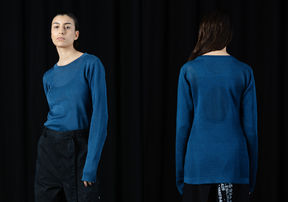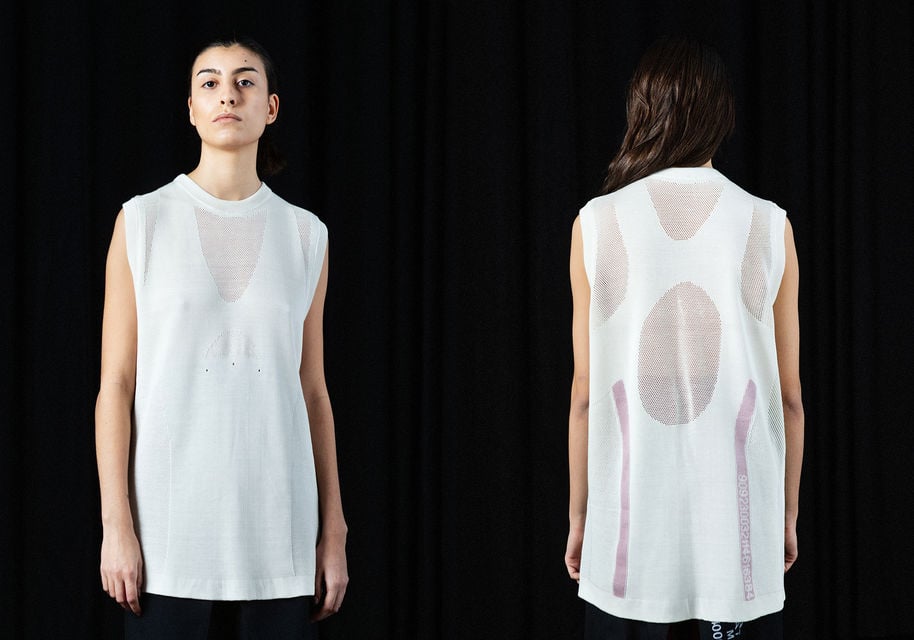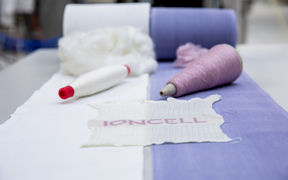Pilot production line for Ioncell launched — a top made with the stronger-than-cotton ecofibre gets its colour from Finnish fields

The Ioncell method has made a huge leap forward this year, as its long-awaited pilot production line was launched on the Aalto University campus. The method turns wood-based materials and textile waste into ecological, high-quality fibres. The construction of the pilot production line was made possible with the support of the Jane and Aatos Erkko Foundation.
Until the pilot line came into use, the novel fibres were produced in a laboratory at a daily production rate of approximately 100 grams. The pilot line uses a continuous manufacturing process with an expected output of up to 10 kilograms a day. According to Professor Herbert Sixta, who led the research, pilot production is on its way to meeting that target.
‘The continuous process is completely different from producing fibre in small batches. We have improved our recycling methods to achieve an almost 100% recovery rate for the cellulose solvent used in the process in the laboratory, which we will also gradually achieve in the pilot plant. At the same time, solvent recovery will be integrated into the continuous fibre process to achieve a closed-loop operation.’
Marja Rissanen, a researcher in the Ioncell group, dyed a batch produced in the pilot line with natural indigo. It is a blue biodye produced by the company Natural Indigo from a flowering plant called woad, grown in Nivala, Finland. After dyeing, Rissanen spun the fibre into thread and tested its durability.
‘The tensile strength was clearly higher than that of cotton or viscose,’ she says with satisfaction.
Aalto University alumna Kasia Gorniak and master’s student Elina Onkinen knitted the thread into fabric for their sportswear-top design.
‘Having worked with this yarn first-hand, I am excited at the prospect of it being applied more widely and commercially in the future — it’s both soft and durable,’ Gorniak explains.
‘I’ve really enjoyed creating a garment that combines many forward-thinking approaches: the Ioncell process, Finnish indigo dye, design longevity and future functionality,’ says Onkinen.

Ioncell method can also be used to turn textile waste into high-quality fibres. The material of this top, designed by Elina Onkinen and Kasia Gorniak, is 100 % Ioncell made of recycled cotton waste (white and blue cloth towels from Lindström) and spun in the laboratory. Photo: Diana Luganski
Towards commercialisation
The process of establishing a company to commercialise the Ioncell method is well underway, and the recruitment of a managing director is in its final stages. The company will start operations in early 2022.
‘Consumers and investors now have a keen interest in sustainable textiles, which makes this an ideal time to establish a spin-off company. By setting up Ioncell, we are responding to consumer expectations in the most efficient way possible,’ says Janne Laine, Vice President for Innovation at Aalto University.
In the future, the pilot production line will also be used for other kinds of research. Professor Michael Hummel, for example, will use the line in efforts to develop wood-based carbon fibres as well as a replacement material for cellophane.
‘The pilot line was largely built with donated funds. It’s really important to us to use the pilot line to support the university’s research activities in the future as well ,’ says Sixta.
Fibre made from recycled cloth towels and hemp stronger than cotton
The tensile strength of fibres created with the Ioncell method is up to 2.5 times more than that of cotton, while an Ioncell knitted fabric made from recycled hemp withstands abrasion for twice as long as normal hemp fabric.

- Published:
- Updated:
Read more news

Get to know us: Associate Professor Maria Sammalkorpi
Sammalkorpi received her doctorate from Helsinki University of Technology 2004. After her defence, she has worked as a researcher at the Universities of Princeton, Yale and Aalto.
Aalto computer scientists in ICML 2024
Computer scientists in ICML 2024
Getting bacteria into line
Physicists use magnetic fields to manipulate bacterial behaviour